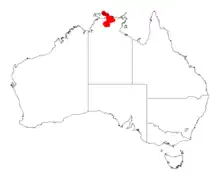| Acacia convallium | |
|---|---|
| Scientific classification | |
| Kingdom: | Plantae |
| Clade: | Tracheophytes |
| Clade: | Angiosperms |
| Clade: | Eudicots |
| Clade: | Rosids |
| Order: | Fabales |
| Family: | Fabaceae |
| Subfamily: | Caesalpinioideae |
| Clade: | Mimosoid clade |
| Genus: | Acacia |
| Species: | A. convallium |
| Binomial name | |
| Acacia convallium | |
 | |
| Occurrence data from AVH | |
Acacia convallium is a tree of the genus Acacia and the subgenus Plurinerves that is endemic to northern Australia.[1]
Description
The tree typically grows to a maximum height of about 6 m (20 ft). It has terete branchlets that have a felty covering of short hairs. Like most species of Acacia it has phyllodes rather than true leaves. The evergreen ovate to sickle shaped phyllodes have a length of 9 to 17.5 cm (3.5 to 6.9 in) and a width of 1.2 to 4 cm (0.47 to 1.57 in) with two to four longitudinal nerves and sparsely distributed spreading hairs that are sometimes only found around the base. It blooms between April and May producing inflorescences in groups of four to six with spherical flower-heads containing about 30 creamy to golden yellow coloured flowers.[1]
Taxonomy
The species was first formally described by the botanist Leslie Pedley in 1999 as part of the work Notes on Acacia (Leguminosae: Mimosoideae) chiefly from northern Australia as published in the journal Austrobaileya. Pedley reclassified it as Racosperma convallium in 2003 but it was transferred back to genus Acacia in 2006.[2]
Distribution
It is restricted to a small area in the top end of the Northern Territory along the Coburg Peninsula and the upper catchments of the Alligator and Liverpool Rivers where it is commonly situated in gorges or sandstone escarpments growing in skeletal sandy or deep sandy soils.[1]
See also
References
- 1 2 3 "Acacia convallium Pedley". Wattle - Acacias of Australia. Lucid Central. Retrieved 28 September 2020.
- ↑ "Acacia convallium Pedley". Atlas of Living Australia. Global Biodiversity Information Facility. Retrieved 28 September 2020.